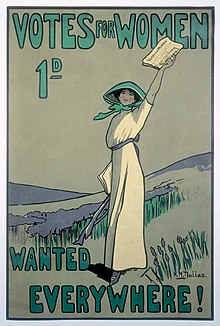Votes for Women (magazine)
Votes for Women was a magazine in the United Kingdom that dealt with the women's rights movement in the early 20th century. Until 1912 it was the official newsletter of the Women's Social and Political Union , the leading organization of the suffragettes . It was subsequently continued in a smaller edition, first independently and then as an organ of the "United Suffragists".
history

Beginnings
The magazine was founded in October 1907 by Emmeline Pethick-Lawrence and her husband Frederick. The two became editors of the magazine that was published by St Clement's Press. It became the official news outlet for the Women's Social and Political Union (WSPU), which was already the country's leading militant suffragette organization. Many of the specimens were sold to women or men by the WSPU members on the street. The pavement sellers were often harassed by passers-by and they were forced to stand in the gutter if they didn't want to be locked up by the police for “obstruction of the pavement”.
The magazine initially cost three pence and was published monthly, with weekly updates. From April 1908 it was published weekly and the following month the price was reduced to just a penny. During this period, the WSPU viewed the magazine as a tool for recruiting and soliciting donations. Therefore, a lot of time was invested in increasing the spread. For example, in the summer when they went on vacation at the sea, the members of the WSPU were obliged to acquire new subscribers.
Climax
The magazine was redesigned in 1909 and the page format enlarged. The WPSU started a major advertising campaign that also included a bus touring London, and set up booths in central London. This led the circulation to a peak of 33,000 copies in the first months of 1910.
Changes
In 1912 the Pethick Lawrences were arrested and Evelyn Sharp briefly took over the editing. The Pethick Lawrences were later expelled from the WSPU and thereafter independently published the journal; the supporters were organized in a “Votes for Women Fellowship”. The purpose of this support group should be that members of a number of women's rights organizations could be there, whether they were militant or non-militant. The support group created sub-groups across the country that focused their engagement on education. This led some members to forge a plan for a new action group. In February 1814, Votes for Women announced the formation of the group "United Suffragists", within which the Pethick Lawrences were active. And in August they transferred the management of the magazine to the new group. Sharp then became sole editor of the magazine.
Later years
The magazine also appeared during the First World War , but with a very reduced circulation. And she fought for her financial independence. Sharp geared the paper more towards the tastes of middle-class women; the slogan was "The War Paper for Women" (Eng .: "The war newspaper for women"). Although she personally developed into an opponent of the war, she ensured the maintenance of a neutral orientation of the paper.
The struggle for women's rights had largely subsided in early 1918 and in March of that year the "United Suffragists" disbanded, whereupon the magazine also ceased publication.
Web links
- Article on “Votes for Women”. Accessed October 27, 2018
- Online archive of 354 issues between October 17, 1907 and January 28, 1916
Individual evidence
- ↑ Elizabeth Crawford: The Women's Suffrage Movement: A Reference Guide 1866-1928 . UCL Press, London 1999, ISBN 184142031X , pp. 460-461.
- ↑ June Purvis, Sandra Stanley Holton: Votes For Women . Routledge, London 2000, ISBN 0415214580 , p. 138.
- ^ Bonnie Kime Scott: Gender in Modernism: New Geographies, Complex Intersections . University of Illinois Press, Urbana 2007, ISBN 0252031717 , p. 31.
- ↑ Krista Cowman: Women in British Politics, c.1689-1979 . Palgrave Macmillan, Basingstoke 2010, ISBN 0230545572 , p. 62.
- ^ Sandra Stanley Holton: Feminism and Democracy: Women's Suffrage and Reform Politics in Britain . Cambridge University Press, Cambridge 1987, ISBN 0521328551 , pp. 128, 181.
- ↑ Elizabeth Crawford: The Women's Suffrage Movement: A Reference Guide 1866-1928 . UCL Press, London 1999, ISBN 184142031X , p. 629.
- ↑ Barbara Green: Feminist Periodicals and Daily Life: Women and Modernity in British Culture . Palgrave Macmillan, Cham, Switzerland 2017, ISBN 9783319632773 , pp. 211-212.
- ↑ Elizabeth Crawford: The Women's Suffrage Movement: A Reference Guide 1866-1928 . UCL Press, London 1999, ISBN 184142031X , p. 694.


